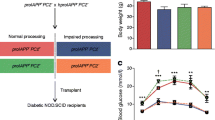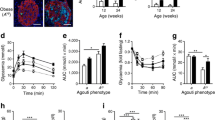Abstract
Background
Several mouse strains expressing human islet amyloid polypeptide (IAPP) have been created to study development of islet amyloid and its impact on islet cell function. The tendency to form islet amyloid has varied strongly among these strains by factors that have not been elucidated. Because some beta cell granule components are known to inhibit IAPP fibril formation in vitro, we wanted to determine whether a mouse strain expressing human IAPP but lacking the nonamyloidogenic mouse IAPP is more prone to develop islet amyloidosis.
Materials and Methods
Such a strain was created by cross-breeding a transgenic mouse strain and an IAPP null mouse strain.
Results
When fed a fat-enriched diet, male mice expressing only human IAPP developed islet amyloid earlier and to a higher extent than did mice expressing both human and mouse IAPP. Supporting these results, we found that mouse IAPP dose-dependently inhibits formation of fibrils from human IAPP.
Conclusions
Female mice did not develop amyloid deposits, although small extracellular amorphous IAPP deposits were found in some islets. When cultivated in vitro, amyloid deposits occurred within 10 days in islets from either male or female mice expressing only human IAPP. The study shows that formation of islet amyloid may be dependent on the environment, including the presence or absence of fibril inhibitors or promoters.





Similar content being viewed by others
References
Westermark P, Johnson KH, O’Brien TD, Betsholtz C. (1992) Islet amyloid polypeptide a novel controversy in diabetes research. Diabetologia 35: 297–303.
Schmitz O, Nyholm B, Juhl CB, Lund S, Ørskov L. (1999) Aspects on secretion and actions of amylin: interplay between amylin and other hormones. J. Endocrin. Invest. 22(suppl 5): 33–36.
Westermark P, Wernstedt C, Wilander E, Sletten K. (1986) A novel peptide in the calcitonin gene related peptide family as an amyloid fibril protein in the endocrine pancreas. Biochem. Biophys. Res. Commun. 140: 827–831.
Westermark P. (1996) Islet pathology of non-insulin-dependent diabetes mellitus (NIDDM). Diabet. Med. 13: S46–48.
Kahn SE, Andrikopoulos S, Verchere CB. (1999) Islet amyloid: a long-recognized but underappreciated pathological feature of type 2 diabetes. Diabetes 48: 241–253.
Janson J, Ashley RH, Harrison D, McIntyre S, Butler PC. (1999) The mechanism of islet amyloid polypeptide toxicity is membrane disruption by intermediate-sized toxic amyloid particles. Diabetes 48: 491–498.
Betsholtz C, Svensson V, Rorsman F, et al. (1989) Islet amyloid polypeptide (IAPP): cDNA cloning and identification of an amyloidogenic region associated with the species-specific occurrence of age-related diabetes mellitus. Exp. Cell Res. 183: 484–493.
Westermark P, Engström U, Johnson KH, Westermark GT, Betsholtz C. (1990) Islet amyloid polypeptide: pinpointing amino acid residues linked to amyloid fibril formation. Proc. Natl. Acad. Sci. U.S.A. 87: 5036–5040.
D’Alessio DA, Verchere CB, Kahn SE, et al. (1994) Pancreatic expression and secretion of human islet amyloid polypeptide in a transgenic mouse. Diabetes 43: 1457–1461.
de Koning EJ, Höppener JW, Oosterwijk C, et al. (1993) Localisation of islet amyloid polypeptide (IAPP) in pancreatic islets of transgenic mice expressing the human or rat IAPP gene. Biochem. Soc. Trans. 21: 26S.
Fox N, Schrementi J, Nishi M, et al. (1993) Human islet amyloid polypeptide transgenic mice as a model of non-insulin-dependent diabetes mellitus (NIDDM). FEBS Lett. 323: 40–44.
Yagui K, Yamaguchi T, Kanatsuka A, et al. (1995) Formation of islet amyloid fibrils in beta-secretory granules of transgenic mice expressing human islet amyloid polypeptide/amylin. Eur. J. Endocrinol. 132: 487–496.
Verchere CB, D’Alessio DA, Palmiter RD, et al. (1996) Islet amyloid formation associated with hyperglycemia in transgenic mice with pancreatic beta cell expression of human islet amyloid polypeptide. Proc. Natl. Acad. Sci. U.S.A. 93: 3492–3496.
Soeller WC, Janson J, Hart SE, et al. (1998) Islet amyloid-associated diabetes in obese A(vy)/a mice expressing human islet amyloid polypeptide. Diabetes 47: 743–750.
Janson J, Soeller WC, Roche PC, et al. (1999) Spontaneous diabetes mellitus in transgenic mice expressing human islet amyloid polypeptide. Proc. Natl. Acad. Sci. U.S.A. 93: 7283–7288.
Höppener JWM, Oosterwijk C, Nieuwenhuis MG, et al. (1999) Extensive islet amyloid formation is induced by development of type 2 diabetes mellitus and contributes to its progression: pathogenesis of diabetes in a mouse model. Diabetologia 42: 427–434.
Westermark G, Arora MB, Fox N, et al. (1995) Amyloid formation in response to beta cell stress occurs in vitro, but not in vivo, in islets of transgenic mice expressing human islet amyloid polypeptide. Mol. Med. 1: 542–553.
de Koning EJ, Morris ER, Hofhuis FM, et al. (1994) Intra- and extracellular amyloid fibrils are formed in cultured pancreatic islets of transgenic mice expressing human islet amyloid polypeptide. Proc. Natl. Acad. Sci. U.S.A. 91: 8467–8471.
MacArthur DLA, de Koning EJP, Verbeek JS, Morris JF, Clark A. (1999) Amyloid fibril formation is progressive and correlates with beta-cell secretion in transgenic mouse isolated islets. Diabetologia 42: 1219–1227.
Westermark P, Li ZC, Westermark GT, Leckström A, Steiner DF. (1996) Effects of beta cell granule components on human islet amyloid polypeptide fibril formation. FEBS. Lett. 379: 203–206.
Janciauskiene S, Eriksson S, Carlemalm E, Ahrén B. (1997) B cell granule peptides affect human islet amyloid polypeptide (IAPP) fibril formation in vitro. Biochem. Biophys. Res. Commun. 236: 580–585.
Gebre-Medhin S, Mulder H, Pekny M, et al. (1998) Increased insulin secretion and glucose tolerance in mice lacking islet amyloid polypeptide (amylin). Biochem. Biophys. Res. Commun. 250: 271–277.
Westermark GT, Leckström A, Ma Z, Westermark P. (1998) Increased release of IAPP in response to long-term high fat intake in mice. Horm. Metab. Res. 30: 256–258.
Westermark GT, Johnson KH, Westermark P. (1999) Staining methods for identification of amyloid in tissue. Meth. Enzymol. 309: 3–25.
Ma Z, Westermark GT, Johnson KH, O’Brien TD, Westermark P. (1998) Quantitative immunohistochemical analysis of islet amyloid polypeptide (IAPP) in normal, impaired glucose tolerant, and diabetic cats. Amyloid 5: 255–261.
LeVine H III. (1999) Quantification of β-sheet amyloid fibrils structures with thioflavin T. Meth. Enzymol. 309: 274–284.
Wisniewski T, Frangione B. (1992) Apolipoprotein E a pathological chaperone protein in patients with cerebral and systemic amyloid. Neurosci. Lett. 135: 235–238.
Young ID, Ailles L, Narindrasorasak S, Tan R, Kisilevsky R. (1992) Localization of the basement membrane heparan sulfate proteoglycan in islet amyloid deposits in type II diabetes mellitus. Arch. Pathol. Lab. Med. 116: 951–954.
Ashburn TT, Lansbury PT. (1993) Interspecies sequence variation affects the kinetics and the thermodynamics of amyloid formation: peptide models of pancreatic amyloid. J. Am. Chem. Soc. 115: 11012–11013.
Westermark P, Eizirik D, Pipeleers DG, Hellerström C, Andersson A. (1995) Rapid deposition of amyloid in human islets transplanted into nude mice. Diabetologia 38: 543–549.
Clark A, Charge SB, Badman MK, de Koning EJ. (1996) Islet amyloid in type 2 (non-insulin-dependent) diabetes. A.P.M.I.S. 104: 12–18.
Arnelo U, Permert J, Adrian TE, Larsson J, Westermark P, Reidelberger RD. (1996) Chronic infusion of islet amyloid polypeptide causes anorexia in rats. Am. J. Physiol. 271: R1654–1659.
Arnelo U, Blevins JE, Larsson J, et al. (1996) Effects of acute and chronic infusion of islet amyloid polypeptide on food intake in rats. Scand. J. Gastroenterol. 31: 83–89.
Acknowledgments
This work was supported by the Swedish Medical Research Council (project No 5941), the Research Fund of the Swedish Diabetes Association, and the Novo Nordisk Foundation.
Author information
Authors and Affiliations
Corresponding author
Rights and permissions
About this article
Cite this article
Westermark, G.T., Gebre-Medhin, S., Steiner, D.F. et al. Islet Amyloid Development in a Mouse Strain Lacking Endogenous Islet Amyloid Polypeptide (IAPP) but Expressing Human IAPP. Mol Med 6, 998–1007 (2000). https://doi.org/10.1007/BF03402051
Accepted:
Published:
Issue Date:
DOI: https://doi.org/10.1007/BF03402051




